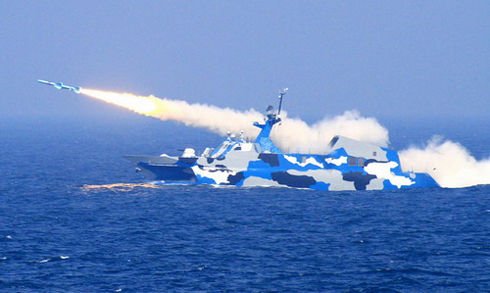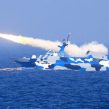
Aims and Motives of China’s East China Sea Live Fire Drills
Publication: China Brief Volume: 10 Issue: 14
By:

The Chinese Ministry of National Defense announced on June 24 that all vessels would be prohibited from entering areas located east of Zhoushan to Taizhou city in Zhejiang in the East China Sea from June 30 to July 5. During that time period, the People’s Liberation Army Navy (PLAN) conducted a six-day, live ammunition drill in a move that analysts say may be in response to a planned joint exercise between the United States and Republic of Korea (ROK) navies in the Yellow Sea. In spite of a lack of expert agreement over Chinese intentions, one aspect of the exercise seems clear, the combined arms exercise demonstrates the PLA’s growing integrated war-fighting capabilities.
The live-fire drill was executed by Fast Attack Craft Unit 91765 of the PLA Navy’s East China Sea Fleet, reportedly with support from Unit 92910 (China Times, June 29). According to the mouthpiece of the Chinese army, PLA Daily, the naval drill in the East China Sea involved squadrons of minesweepers, landing ships, submarine chasers and frigates. The most advanced among the sophisticated array of weaponry is the indigenously-made Houbei class Type 022 catamaran missile fast attack craft, a high-speed stealth missile boat, which experts say is capable of launching covert, long-range attacks (Global Times, July 1). The Type 022 has the capacity of being armed with eight YJ-83 anti-ship missiles and possesses a data link antenna for receiving target information from sea- or air-based sensors, which enables an ‘over-the-horizon’ strike capability against surface targets, among others. According to defense experts, these ultra-fast catamarans are designed to fire cruise missiles at carriers in "hit-and-run" attacks.
Further reporting of the exercise indicates that the drill involved 10 naval vessels as well as 10 aircraft to form a large combined arms force (China Times, July 7). The exercises reportedly entailed tracking and naval vessels shooting at various targets in eight fishery zones within China’s exclusive economic zone (EEZ), where Beijing alleges the U.S. military has repeatedly sent ships and aircraft for reconnaissance missions (People’s Daily, July 1).
A senior official in the PLAN’s East Sea Fleet cited by PLA Daily stated that the drill has helped improve the Chinese navy’s capacity to engage in missions under complex electromagnetic condition. Furthermore, the drill deepens new war fighting strategies and tested the military’s integrated defense capabilities (China Times, July 7). The official’s statement suggests that the Chinese military has been making strides in overcoming its weakness in electromagnetic defense at sea. More importantly, it follows in line with Chinese efforts toward training under “complex electromagnetic conditions,” which necessitates such activities as jamming, electronic attacks, reconnaissance and electronic deception.
The timing of the live-fire exercise gains salience against the backdrop of a planned U.S. and ROK combined military drill in early June that was intended to counter North Korea’s sinking of the ROK warship Cheonan in late March. The exercise may involve the deployment of the USS George Washington, the U.S. Nimitz class aircraft carrier. Soon after the PLAN drill was announced, the U.S.-ROK anti-submarine exercise was delayed until mid-June, and again postponed to the last week of June. Then on June 28, the ROK again delayed the drill to July in order to ensure U.S. attendance (People’s Daily, July 2).
In a meeting with reporters on July 2, General Ma Xiaotian, deputy chief of general staff of the PLA, stated that the location of the upcoming U.S.-ROK drill is very close to China’s maritime border, and thus Beijing strongly opposed it. General Ma’s comment has been interpreted by some analysts as being related to the presence of the aircraft carrier USS George Washington near Chinese shores (People’s Daily, July 2).
Yet, according to Liu Jiangping, a Chinese navy expert interviewed by Hong Kong-based Wen Wei Po, the drill in the East China Sea is not directed at another country. In fact, Liu argues, naval exercises in the East China Sea have become more common in recent years. Li cites East Sea Fleet exercises in February 2008, July 2009 and the one held in the earlier half of this year, in different areas of the East China Sea. However, Liu emphasized that, even though this particular drill may not be directed at another country, if there is a perceived threat on China’s periphery, the PLA will not remain idle (Wen Wei Po [Hong Kong], June 29).
Not everyone agrees. "Though the Chinese government did not say anything about the drill, anybody with common sense on military strategy will bet that they are related," said Shi Yinhong, a senior expert on U.S. studies at Beijing-based Renmin University of China (People’s Daily, July 2).
Xu Guangyu, a senior researcher at the China Arms Control and Disarmament Association, which is described on its website as a non-governmental organization but made up of researchers affiliated with government agency-tied think tanks, told the Global Times that the U.S.-ROK military operation would not only escalate tension between the two Koreas, but also exert negative influence on Sino-U.S. military relations. "The joint military drill is not an irreplaceable measure for Washington to support Seoul on punishing Pyongyang over the alleged torpedoing of the warship Cheonan," he said (Global Times, July 6).
In an apparent reference to General Ma’s remarks regarding the Yellow Sea exercise, "China’s position on the Yellow Sea issue demonstrates its resolution to safeguard national rights and interests," said Xu Guangqian, a military strategist at the PLA Academy of Military Sciences. "It also reflects that China is increasingly aware of the fact that its strategic space has confronted threats from other countries" (Global Times, July 6).
While the Chinese military’s announcement of the live-fire drill is a welcome improvement to the PLA’s oft-mute approach to military transparency, it should also be seen in the context of a core strategy of Chinese deterrence. Along this line, regular military exercises not only boost the Chinese armed forces’ combat capabilities, but also function as a crucial means of conventional deterrence. According to a Global Times editorial, “Transparency has a crucial role in maintaining effective deterrence … the capabilities of conventional military drills need to be enhanced to ensure protection of its sovereignty and territorial integrity. Transparency can extend the reach of conventional deterrence” (Global Times, July 1).
In the final analysis, the live-fire test appears to reflect a carefully calibrated move by Chinese authorities. It is worth noting what General Ma Xiaotian said at the Shangri-La conference in Singapore on June 5 that, one of the major obstacles in China-U.S. military relations is the "high-intensity surveillance of U.S. warships and planes in the South China Sea and East China Sea"—areas that China defines as its core interests. Against this backdrop, the live-fire drill not only displays the PLA’s growing integrated war-fighting capabilities, but is also a clear demonstration of Chinese deterrence and the growing sophistication of its military strategy.





